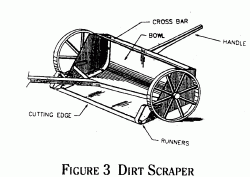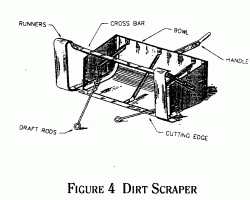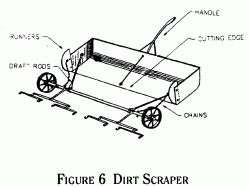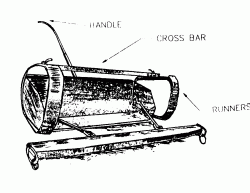





FRESNO SCRAPER
BACKGROUND
For centuries, the soil of the earth has been moved by mankind for agriculture and construction. In some underdeveloped countries, it is still moved in baskets, carried on the head, or hung from a pole slung across the shoulders.
The earliest use of draft animals to pull the Slip/Scoop, (Figure 1) is attributed to Flemish Husbandry. The single handle was later replaced by two handles for better lateral control of scraping, sliding and dumping the load into a pile.
In the middle of the 1800's the Buckboard was developed in the Western United States. Essentially, it was a board which was hot-se drawn in an upright position to scrape and push the soil from a high spot into the low spots, smoothing and leveling the ground. The Buckboard was provided with a tailboard upon which the driver stood until ready to dump the soil. Slip/Scoops and Buckboards were often used in combination to smooth and level piles of earth dumped by the Slip/Scoops. This was particularly true in the earliest agricultural development of the San Joaquin and Sacramento Valleys of California.
EVOLUTION
The history of the Fresno Scraper starts with James Porteous, born in Scotland in 1848. His father, William Porteous, was a wheelwright and blacksmith who built and repaired carriages, wagons and farm equipment. After learning his basic skills, James Porteous headed for Santa Barbara, California, in the company of friends. In 1877, he came to Fresno, (Photo 1) and established a wagon shop in the downtown area. He prospered, manufacturing buggies and heavy wagons.
Working with Fresno farmers, Porteous recognized the valley's dependence on irrigation. This necessitated more efficient means of constructing canals, ditches, borders, furrows, stock ponds, etc. In his efforts to better current methods used, James Porteous became an inventor, an entrepreneur and a manufacturer.
Porteous' first invention was to improve the Buckboard by overcoming major problems: (a) the tail board, rigidly secured to the Buckboard, would swing up into the air to dump the load, and (b) the pushing of the load against soil required considerable power. Porteous' answer to these problems was his first Buck Scraper, U.S. Patent 261,759 issued July 25, 1882. (Figure 2)
In this first invention, the tailboard is hinged to the Buck Scraper. When the lever is moved to the rear, the soil pushed by the board is carried on the rear runners. When the lever is moved forward, the load is dumped so the front runners act as a gauge to grade the soil to a fixed depth. The disadvantages were (a) much of the pushed soil fell off while tilting the board to the horizontal, and (b) the depth of grading was fixed. Porteous' second invention was his Dirt Scraper, U.S. Patent 275,075 issued April 3, 1883, (Figure 3)
PORTEOUS' SECOND PATENT
This second Porteous patent relates to "means for limiting the rotation of the scraper bowl to dump the load to a controlled depth" when the handle is pushed up. The cross bar may be adjusted forward or back on the bowl side plates to vary the limit position of the bowl as it strikes the tongue. The side runners or shoes raise the cutting edge above the ground. The three principal problems with this invention were: (a) the high rolling resistance of the iron wheels in the soft or sandy soils, (b) the tendency of the scraper to overrun the horses on firm down slopes, and (c) the short runners sinking into soft or sandy soils.
William Deidrick of Selma, California, was awarded U.S. Patent 275, 893 issued April 17, 1883, (Figure 4), to overcome the problems of Porteous' second invention. Deidrick eliminated the wheels by utilizing long, flat, adjustable runners while retaining the bowl, handle and cross bar of Porteous' second patent. Whenever the cross bar position is changed, however, the runners need to be adjusted so that they run flat on the ground, otherwise they would drag on the front or rear tip ends. This adjustment required lifting the bowl up into the desired dump position and using wrenches to adjust both the cross bar and the runners. Nevertheless, the long runners were an important step in the evolution of the Fresno Scraper.
Meanwhile, Porteous made his third invention, U.S. Patent 289,134 issued November 27, 1883.
PORTEOUS' THIRD PATENT
In this third patent, Porteous retained the general features of his second scraper, but substituted the cross bar with a more complicated means on the handle and tongue to adjust the thickness of the dump. Another approach to an adjustable means to vary the dump and use of curved runners was invented by Frank Dusy and Abijah McCall, also of Selma, California, U.S. Patent 320,055 issued June 16, 1885, (Figure 6).
DUSY AND MCCALL PATENT
Dusy and McCall used chains to control and adjust the dump by selecting the desired link to connect to hooks on each end of the draft axle. The circular arc runners to gauge the dump depth, while good in principle, were ineffective due to being so narrow as to slice through the soft, sandy soils. James Porteous bought the rights to the Deidrick patent by assignment dated January 31, 1889, and the Dusy and McCall patent assignment, dated February 7, 1896. Using some of the features of these patents along with his own ideas, Porteous perfected the scraper which became known as the "Fresno Scraper" (Figure 7), and commonly known as a "Fresno."
The three modes of operation of the Fresno Scraper are illustrated here. "Fresnos" were sold throughout the west and when their reputation for efficiency, reliability and ease of operation was established, they were shipped to practically every state as well as South America, India, The Orient, South Africa, Australia and Europe. The "Fresno" played a vital role in the construction of the Panama Canal.
HISTORICAL SIGNIFICANCE
The Fresno Scraper transformed the backbreaking labor of land leveling, ditch digging and road and railroad building. It helped to change the way that earth could be scraped, moved, dumped and leveled. The "Fresno" and its variants made possible the early-day irrigation canals, ditches, and level fields in the Central Valley of California, as well as the construction of dams, roads and railroad right-of-ways. It indeed was the forerunner and provided the basis for the development of the modem day earth-moving scraper.
Present day scrapers are built to scrape up to 30 cubic yards and to carry such loads at speeds up to 30 mph. The advent of the tractor in the 1910-20's, displaced the horses and mules, and provided mechanical and hydraulic control means to aid the operator. Laser beam controlled scrapers have also reduced surveying and operator skill requirements for land leveling for agricultural and construction.


James Porteous
.jpg)

